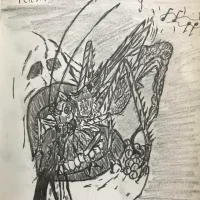Pelesit : The Grasshopper Spirit
Listen
At a glance
| Description | |
|---|---|
| Origin | Malaysian Mythology |
| Classification | Spirits |
| Family Members | N/A |
| Region | Malaysia |
| Associated With | Shamans, Black Magic |
Pelesit
Introduction
In the haunting folklore of Malaysia, the Pelesit stands as one of the most mysterious and feared entities in local mythology. This small, cricket-like spirit is deeply intertwined with the region’s pre-Islamic animist beliefs, later merging with Malay shamanic and Islamic mystical traditions. Unlike benevolent household spirits, the Pelesit is almost always associated with black magic, possession, and emotional manipulation.
The word Pelesit is believed to derive from lesit, meaning “to buzz,” referencing the insect’s eerie sound that signals its presence. Traditionally, the Pelesit serves as a familiar spirit, bound to a human master—usually a woman practicing witchcraft or bomoh hitam (black magic). Through intricate rituals, the spirit becomes a loyal servant, capable of inflicting harm or fulfilling its master’s dark desires.
While some stories portray it as a mere messenger between the living and the dead, most describe the Pelesit as a spiritual weapon—a creature of vengeance, capable of spreading fear, madness, and even death. Its legend remains one of the most enduring symbols of the Malay world’s fascination with the supernatural and the unseen.
Physical Traits
The Pelesit is often described as resembling a cricket or grasshopper, yet those who claim to have seen one insist that it moves unnaturally—its chirp irregular, its eyes glowing faintly in the dark. Though seemingly ordinary, its presence is said to cause an inexplicable chill and unease. Unlike normal insects, the Pelesit’s sound is rhythmic in a disturbing way, often heralding illness or possession.
According to traditional belief, a Pelesit is not born naturally but crafted through forbidden necromancy. Folklore claims that its creation involves taking the tongue of a deceased child, performing incantations, and transforming it into a living familiar. This grim ritual ties the Pelesit eternally to its creator, serving her every command.
At times, it appears as a flickering light darting across shadows, existing between the spiritual and physical realms. During attacks, the Pelesit allegedly enters a victim’s body tail-first through the mouth, symbolizing its defiance of natural order and dominance over human will. The act of invasion marks the beginning of a psychological and physical breakdown, where the victim may fall into delirium or begin speaking incoherently.
Family
The Pelesit does not act alone. It shares an inseparable bond with another supernatural entity known as the Polong—a spirit said to be stored in a small vial of blood by its owner. The Pelesit’s role is to identify and mark the target, after which the Polong arrives to possess and torment the victim. Together, they form a terrifying partnership of precision and destruction, a spiritual symbiosis that amplifies their master’s dark powers.
In the hierarchy of Malay supernatural beings, the Pelesit is often compared to the Bajang, a catlike spirit familiar associated with male sorcerers. While the Bajang is mischievous and chaotic, the Pelesit is strategic, cunning, and precise—traits that align with its association with female practitioners. This gendered distinction reflects the balance often found in Southeast Asian mythology, where male and female spirits represent complementary forces of destruction and control.
The bond between the Pelesit and its master is so strong that it can persist across generations. Some families claim to have inherited a Pelesit, passing it secretly from mother to daughter, ensuring the spirit remains within the bloodline.
Other names
Depending on regional traditions, the Pelesit goes by various names and interpretations. In parts of Sumatra and among the Minangkabau people, it is known as Palasik, though this version often describes a vampiric headhunting spirit that preys on infants, differing from the cricket-like Malaysian entity.
The term Hantu Pelesit (“Pelesit ghost”) is commonly used in Peninsular Malaysia to describe its spectral form, while in some villages, it is colloquially referred to interchangeably with the Bajang due to overlapping attributes. Despite local differences, all these versions share a common thread—the Pelesit’s identity as a spirit familiar tied to black magic, an agent of harm disguised in an unassuming form.
Powers and Abilities
The Pelesit’s abilities are as diverse as they are disturbing. Its primary power lies in possession and manipulation. Once directed by its master, it can travel invisibly to its target, entering the body through the mouth, nose, or ear. Victims soon display symptoms of possession—fever, confusion, and erratic speech. Traditional healers often note that the possessed person will mutter about cats, a strange hallmark used to identify Pelesit influence.
When the Polong joins the attack, the victim’s condition worsens—leading to convulsions or loss of consciousness. In such cases, only a bomoh (traditional shaman) can expel the spirit through exorcism. The ritual often involves commanding the Pelesit to reveal its owner, after which the link between spirit and master can be severed.
Beyond its destructive powers, the Pelesit also acts as a spiritual servant. When not in use, it resides in a small bottle or container, kept close by its owner and “fed” regularly. Its diet—often blood from the owner’s ring finger or turmeric rice—sustains its energy and loyalty. The spirit can enhance its master’s charm, attract fortune, or manipulate others emotionally. However, failure to care for it properly can lead the Pelesit to turn against its master, attacking them with the same fury it once used on enemies.
Disposing of a Pelesit requires careful ritual burial. If destroyed or abandoned without ceremony, it may become a rogue spirit, haunting anyone who disturbs its resting place.
Modern Day Influence
Though Malaysia has modernized rapidly, belief in the Pelesit endures, particularly in rural communities where stories of hauntings and witchcraft remain part of daily life. Its legend continues to serve as a moral warning against greed, jealousy, and misuse of spiritual power.
In literature, the Pelesit’s image has been reimagined in novels like The Girl and the Ghost by Hanna Alkaf, where it symbolizes friendship and trauma rather than evil. In Malaysian horror films, the creature remains a favorite antagonist—its buzzing heralding chaos and dread. Folklore podcasts and digital storytelling platforms have also revived its myth, reinterpreting it through modern psychological and feminist perspectives.
Anthropologists and religious scholars, such as Walter Skeat in Malay Magic (1900), have long studied the Pelesit as an example of animism evolving under Islamic influence—a spirit once born of nature, later reshaped into a cautionary tale of morality and sin.
In popular culture, the Pelesit bridges old superstition with modern storytelling. While many now view it as a relic of myth, others see it as a metaphor for unseen forces—the suppressed fears, desires, and powers that still haunt human consciousness. Whether as a literal haunting or a symbolic echo of ancient belief, the legend of the Pelesit continues to buzz within Malaysia’s cultural imagination, reminding each generation of the delicate boundary between the natural and the supernatural.
Related Images
Source
Alkaf, H. (2020). The Girl and the Ghost. HarperCollins.
Badrie, M. A. (2019). Red Onion, White Onion and Other Malay Legends and Folklores. Kuala Lumpur: Dewan Bahasa dan Pustaka.
Dark Temples. (n.d.). Pelesit. Retrieved October 25, 2025, from https://darktemples.com/pelesit/
Everand. (2025). Ghosts, Spirits and Paranormal Entities from Asian Folklore and Mythology (Vol. 3). Singapore: Everand Media.
Offbeat Folklore Wiki. (n.d.). Pelesit. Retrieved October 25, 2025, from https://offbeat.fandom.com/wiki/Pelesit
Skeat, W. W. (1955). Malay Magic: Being an Introduction to the Folklore and Popular Religion of the Malay Peninsula. Oxford University Press.
Wikipedia. (n.d.). Pelesit. Retrieved October 25, 2025, from https://en.wikipedia.org/wiki/Pelesit
Wisdom Library. (2025). Meaning of the Name Pelesit. Retrieved October 25, 2025, from https://www.wisdomlib.org/names/pelesit
Frequently Asked Questions
What is lorem Ipsum?
I am text block. Click edit button to change this text. Lorem ipsum dolor sit amet, consectetur adipiscing elit. Ut elit tellus, luctus nec ullamcorper mattis, pulvinar dapibus leo.
What is lorem Ipsum?
I am text block. Click edit button to change this text. Lorem ipsum dolor sit amet, consectetur adipiscing elit. Ut elit tellus, luctus nec ullamcorper mattis, pulvinar dapibus leo.
What is lorem Ipsum?
I am text block. Click edit button to change this text. Lorem ipsum dolor sit amet, consectetur adipiscing elit. Ut elit tellus, luctus nec ullamcorper mattis, pulvinar dapibus leo.
What is lorem Ipsum?
I am text block. Click edit button to change this text. Lorem ipsum dolor sit amet, consectetur adipiscing elit. Ut elit tellus, luctus nec ullamcorper mattis, pulvinar dapibus leo.
What is lorem Ipsum?
I am text block. Click edit button to change this text. Lorem ipsum dolor sit amet, consectetur adipiscing elit. Ut elit tellus, luctus nec ullamcorper mattis, pulvinar dapibus leo.










